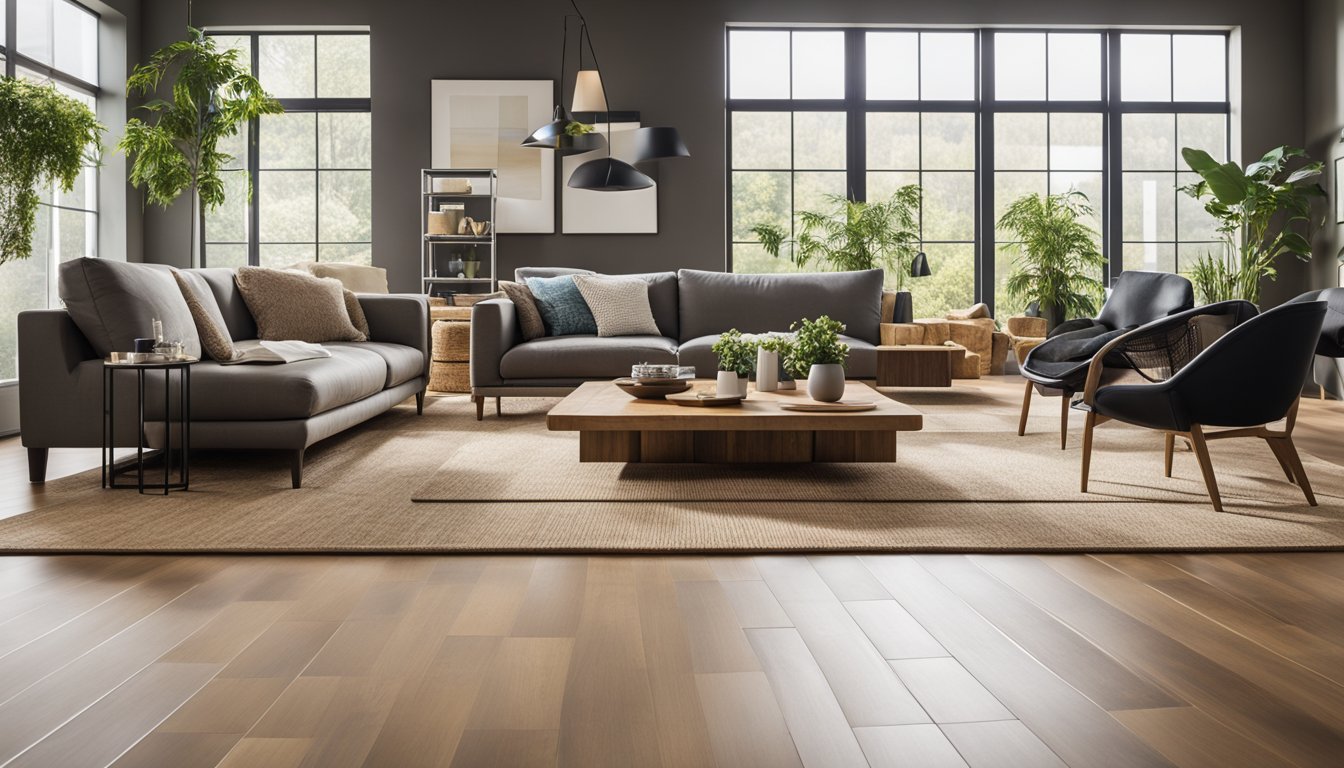Late updated: 21 Oct 2024 11:10
Written by: Daniel Harper
Innovative Sustainable Flooring Ideas: Transforming Interiors with Eco-Friendly Materials
In the world of home design, sustainable flooring is no longer a niche market but a rapidly growing trend that appeals to eco-conscious homeowners and designers alike. Our exploration into innovative sustainable flooring ideas reveals a realm of possibilities that harmonise environmental responsibility with style and durability. Sustainable flooring options like bamboo, cork, and recycled materials offer the unique combination of aesthetic appeal and lower environmental impact.

We are witnessing a revolution in the flooring industry where new technologies intersect with traditional materials to create eco-friendly solutions. These solutions include transforming waste into high-quality materials that maintain a long-lasting performance. By opting for sustainable flooring, we collectively contribute to reducing our carbon footprint, making choices that benefit not only our homes but also our planet.
Navigating through these innovative options, we discover that choosing sustainable flooring goes beyond aesthetics; it involves understanding the impact of materials and considering factors such as lifecycle and renewability. This approach ensures that our choices support long-term sustainability goals while aligning with our design preferences.
Key Takeaways
- Sustainable flooring blends aesthetics with environmental benefits.
- Eco-friendly flooring choices reduce carbon footprint.
- Innovative materials support long-term sustainability goals.
Sustainable Flooring Materials
Incorporating sustainable flooring into our homes helps reduce environmental impact and promote eco-friendly living. Various materials offer distinct benefits, from using natural resources wisely to innovating with recycled and engineered options.
Natural Materials and Their Benefits
Natural flooring materials bring timeless aesthetic and sustainability to our interiors. Bamboo flooring is a prime example, known for its rapid renewability. As a grass, it matures in just 3-5 years, making it an excellent eco-friendly choice compared to traditional hardwood.
Cork flooring, derived from the bark of cork oak trees, retains natural insulating properties and provides a comfortable surface. Plus, the production process utilises waste material from wine bottle corks.
Linoleum, crafted from linseed oil, wood flour, and other natural ingredients, offers a biodegradable option. Its durability and low maintenance also make it a popular eco-friendly flooring selection.
Recycled and Engineered Solutions
Using recycled materials in flooring contributes to waste reduction while offering durable and attractive surfaces. Engineered wood flooring consists of a hardwood veneer on a substrate, often MDF, providing the appearance and feel of solid wood with better resource efficiency.
Reclaimed wood flooring utilises salvaged timber, perfect for creating a rustic or historically inspired décor. Recycled rubber flooring adds practicality, ideal for areas requiring durability and slip resistance, such as gyms or playrooms.
Carpet tiles made from recycled carpet fibres are versatile and practical. They allow easy replacement of individual tiles and contribute to an adorned yet sustainable floor design.
Innovative and Alternative Options
Innovation gives rise to unique materials that enhance sustainability. Glass tiles made from recycled glass offer a sleek, modern finish while conserving resources. Similarly, porcelain and ceramic tiles often feature a high percentage of recycled content and combine longevity with a stylish appearance.
Concrete flooring, when designed with sustainable practices, offers a durable and thermally stable option. It can integrate recycled aggregates or incorporate eco-friendly sealers, ensuring minimal environmental impact.
Rubber flooring, crafted from recycled tyres, provides an impressive sustainable choice. Its resilience and shock absorption make it ideal for high-traffic areas, offering both functionality and an environmentally positive footprint. We continue to explore these innovative materials to balance aesthetics and sustainability in flooring design.
Considerations for Sustainable Flooring Choices

Sustainable flooring involves evaluating numerous factors such as environmental impact, health effects, and maintenance needs. Our goal is to help you make informed choices about flooring that align with eco-friendly principles and practical considerations.
Environmental and Health Impact
Selecting flooring from sustainable sources is crucial for reducing the carbon footprint. Materials like solid wood flooring, harvested responsibly, contribute to a minimal environmental impact. We must also consider the use of volatile organic compounds (VOCs) commonly found in many flooring products. VOCs can affect indoor air quality, impacting health.
Opting for flooring with low or zero VOC emissions ensures a healthier indoor environment. Additionally, choices that provide thermal and acoustic insulation can further promote energy efficiency, contributing to green living initiatives. Prioritising these factors creates a healthier, more sustainable living space for everyone.
Maintenance, Durability, and Aesthetics
When choosing flooring, maintenance and durability are key concerns. Sustainable flooring options like cork and bamboo not only offer aesthetic appeal but are also known for their strength and longevity. These materials require low maintenance, making them ideal for busy households.
We should also consider the aesthetic potential of sustainable flooring. Patterns such as herringbone or wider planks of laminate can enhance the visual appeal of a room. By balancing durability, maintenance, and style, eco-conscious homeowners can enjoy beautiful, functional spaces that align with their sustainable values.
Installation and Lifecycle Considerations
The installation process can significantly impact the overall sustainability of flooring choices. Some materials require professional installation, which can affect long-term costs and resource efficiency. Others are suitable for DIY installation, allowing us to directly contribute to eco-friendly practices.
Lifecycle considerations mean assessing the flooring's durability and its ability to fit into a circular economy. Sustainable products should be recyclable or biodegradable, reflecting responsible sustainable practices. Evaluating these factors ensures that our flooring choices contribute positively to environmental goals throughout their life, from installation to eventual replacement.
Frequently Asked Questions

In our exploration of innovative sustainable flooring ideas, we've identified a range of eco-friendly materials and industry leaders committed to environmentally-conscious practices. Each choice offers unique advantages in both sustainability and design.
What are the top environmentally-friendly flooring options currently available?
Bamboo, cork, and recycled wood are among the leading sustainable flooring materials. They have minimal environmental impact and are increasingly popular due to their durability and aesthetic appeal. Additionally, recycled metal tiles are gaining recognition for turning waste into durable flooring solutions.
How does bamboo fare as a sustainable flooring material?
Bamboo is greatly valued for its fast growth and renewability. It's stronger than many traditional hardwoods and provides a sleek, modern look. Its quick regeneration makes it an ideal choice for sustainable flooring projects.
Which companies lead in the production of eco-friendly flooring?
Several companies are pioneering eco-friendly solutions in the flooring industry. Some have focused on recycling materials, while others employ sustainable harvesting practices. These companies are at the forefront of creating a greener future.
What are the benefits of linoleum in sustainable floor solutions?
Linoleum is made from natural materials like linseed oil and wood flour. It's biodegradable, durable, and comes in a variety of designs, making it a versatile choice for those seeking sustainable flooring. Its natural composition also contributes to a healthier indoor environment.
Can you suggest any eco-friendly alternatives for water-resistant flooring?
For water-resistant flooring, options like recycled rubber and treated bamboo provide excellent resistance. These materials maintain sustainability while offering protection against moisture, making them suitable for kitchens and bathrooms.
In terms of sustainability, how does cork flooring compare to other materials?
Cork is harvested from the bark of cork oak trees, allowing the trees to continue growing. This method makes cork a renewable resource. It also provides heat insulation and noise reduction, setting it apart as a sustainable yet functional flooring option.
